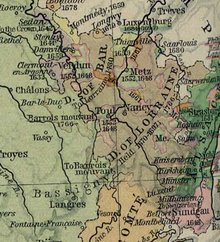Former Roman Catholic diocese in present-day France
Toul Cathedral The Diocese of Toul was a Roman Catholic diocese seated at Toul in present-day France. It existed from 365 until 1802. From 1048 until 1552 (de jure Holy Roman Empire .
History
The diocese was erected in 338 AD by St. Mansuetus . The diocese was a suffragan of the ecclesiastical province of Trier . In 550 AD, the Frankish Council of Toul was held in the city.
By the high Middle Ages , the diocese was located at the western edge of the Holy Roman Empire ; it was bordered by France, the Duchy of Bar , and the Duchy of Lorraine . In 1048 it become a state of the Empire while that city of Toul itself became a Free Imperial City .
In 1552, both states were annexed by King Henry II of France ; the annexations were formally recognized by the Empire in 1648 by the Peace of Westphalia . By then, they were part of the French province of the Three Bishoprics .
In 1766, the Duchy of Lorraine became part of France. In 1777 and 1778, territory was carved out of Toul to form two new dioceses: Saint Dié and Nancy , both of them suffragans of Trier. By the terms of the Concordat of 1802 , Toul was suppressed. Its territory was merged with that of Nancy to form a new diocese — the Diocese of Nancy-Toul with it seat in Nancy . The geographic remit included three Departments of France : Meurthe , Meuse , and Vosges .
List of bishops and prince-bishops
Bishops
Mansuetus 338–375, first bishopAmon c. 400?Alchas c. 423?Gelsimus c. 455?Auspicius c. 478?Ursus around 490Aprus (Aper) 500–507Aladius 508–525?Trifsorich 525–532Dulcitius 532?–549
Alodius c. 549
Premon
Antimund
Eudolius c. 602
Theofred 640–653
Bodo of Toul c. 660
Eborinus around 664
Leudinus 667?–669Adeotatus 679–680
Ermentheus c. 690?
Magnald c. 695?
Dodo c. 705
Griboald 706–739?
Godo 739?–756
Jakob 756–767
Borno 775–794
Wannich 794?–813
Frotar 814–846Arnulf 847–871
Arnald 872–894
Ludhelm 895–905
Drogo 907–922
Gosselin 922–962Gerard I 963–994 (Saint Gerard )
Stephen 994–995
Robert 995–996
Berthold 996–1019Herman 1020–1026
Prince-Bishops
Bruno Egisheim-Dagsburg † (1026 - 12 February 1049; elected as Pope Leo IX , served until his death in 1054)Sede Vacant 1049-1051
Odo 1052–1069
Pippo 1070–1107Richwin of Commercy 1108–1126
Henry I of Lorraine 1127-1167
Peter of Brixey 1168–1192Odo of Vaudemont 1192–1197
Matthias of Lorraine 1197–1206, † 1217
Reinald of Chantilly 1210–1217
Gerard II of Vaudemont 1218–1219
Odo II of Sorcy 1219–1228
Garin 1228–1230
Roger of Marcey 1231–1251
Giles of Sorcy 1253–1271
Conrad II of Tübingen 1272–1296
John I of Sierck 1296–1305Vito Venosa 1305–1306
Odo III of Grançon 1306–1308
Giacomo Ottone Colonna 1308–1309
John II of Arzillières 1309–1320
Amatus of Geneva 1320–1330
Thomas of Bourlemont 1330–1353
Bertram de la Tour 1353–1361
Pietro di la Barreria 1361–1363
John III of Hoya 1363–1372
John IV of Neufchatel 1373–1384, † 1398
Savin de Floxence 1384–1398
Philip II de la Ville-sur-Illon 1399–1409
Henry II de la Ville-sur-Illom 1409–1436
Louis de Haraucourt 1437–1449
Guillaume Fillastre 1449–1460John V de Chevrot 1460
Anthony I of Neufchatel 1461–1495
Ulric of Blankenberg 1495–1506 Nicholas Francis, cardinal, duke of Lorraine Hugh des Hazards 1506–1517
John, Cardinal of Lorraine 1517–1524, † 1544 (Bishop of Verdun 1523–1544)Hector de Ailly-Rochefort 1526–1532
John, Cardinal of Lorraine (again) 1532–1537
Anthony II Pellagrin 1537–1542
John of Lorraine-Guise (again) 1542–1543, † 1544
Bishops after the French annexation
See also
References
Bibliography
Reference Sources
Gams, Pius Bonifatius (1873). Series episcoporum Ecclesiae catholicae: quotquot innotuerunt a beato Petro apostolo Eubel, Conradus, ed. (1913). Hierarchia catholica, Tomus 1 Eubel, Conradus, ed. (1914). Hierarchia catholica, Tomus 2 Eubel, Conradus, ed. (1923). Hierarchia catholica, Tomus 3 Gauchat, Patritius (Patrice) (1935). Hierarchia catholica IV (1592-1667) . Retrieved 2016-07-06 . Ritzler, Remigius; Sefrin, Pirminus (1952). Hierarchia catholica medii et recentis aevi V (1667-1730) . Retrieved 2016-07-06 .
Studies
External links
48°41′N 5°53′E / 48.68°N 5.89°E / 48.68; 5.89
International National Other




